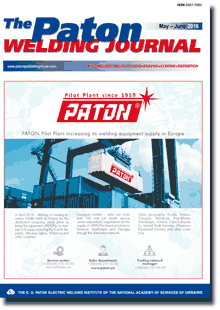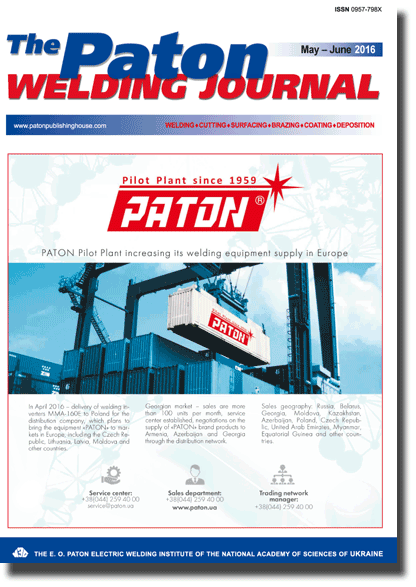Access for download PDF files for subscribers and for reviewers of scientometric bases.
Organization: Elsevier for content access(PDF files of journals released before 2024 are available for download from the website's archives))
Organization: Elsevier for content access(PDF files of journals released before 2024 are available for download from the website's archives))
| 2016 №06 (13) |
DOI of Article 10.15407/tpwj2016.06.14 |
2016 №06 (15) |

The Paton Welding Journal, 2016, #5-6, 80-85 pages
Effect of structure and properties of aluminium-lithium alloy welded joints produced by argon-arc and friction stir welding methods
L.I. Markashova, A.G. Poklyatsky And O.S. Kushnaryova
E.O. Paton Electric Welding Institute, NASU 11 Kazimir Malevich Str., 03680, Kiev, Ukraine. E-mail: office@paton.kiev.ua
Abstract
An essential difference in formation of structural-phase state at application of different welding conditions — friction stir welding compared to argon-arc welding — is considered in the case of welded joints of complex aluminium-lithium alloys. The urgency of comprehensive experimental-analytical assessment of interrelation of welded joint structure and properties is also shown. Assessments of specific contribution of structural-phase state (chemical composition, phase dimensions, grain, subgrain and dislocation structure) into the change of the main service properties of welded joints made by argon-arc welding and friction stir welding are considered, as well as the influence of welded joint structural state on the nature of distribution, level of growing internal stresses and their relaxation mechanisms under specific welding conditions. 10 Ref., 5 Figures.
Keywords: aluminium alloy, FSW, TIG welding, weld metal, phase precipitates, structure, dislocations, strengthening, strength characteristics, crack resistance
Received: 05.04.16
Published: 19.07.16
References
- Fridlyander, I.N. (2000) Aluminium alloys in flying vehicles for periods of 1970–1999 and 2000–2015. In: of 5th Session of Sci. Council on New Materials on Problems of Modern Materials Science, 15–19. Kiev: Naukova Dumka.
- Goldshtejn, M.I., Litvinov, V.S., Bronfin, B.M. (1986) Metallophysics of high-strength alloys. Moscow: Metallurgiya.
- Markashova, L.I., Alekseenko, T.A., Kushnaryova, O.S. et al. (2011) Role of structure in optimization of strength, ductility, crack resistance properties of welded joints. In: Building, Materials Science, Machine-Building: , Issue 58, 446–452. Dnepropetrovsk: GVUZ PGASA.
- Markashova, L., Kushnareva, O. (2014) Effect of structure on the mechanical properties of the metal of welded joints of aluminum alloys of the Al–Cu–Li system. Materials Sci., Vol. 49, Issue 5, 681–687.
- Ashby, M.F. (1972) On the orowan stress. In: Physics of strength and plasticity, 88–107. Moscow: Metallurgiya.
- Markashova, L.I., Ishchenko, A.Ya., Kushnaryova, O.S. et al. (2012) Effect of structural-phase transformations in aluminium-lithium alloy 1460 joints on physical-mechanical properties. The Paton Welding J., 5, 17–25.
- Markashova, L.I., Poklyatsky, A.G., Kushnaryova, O.S. (2015) Role of structural-phase state in change of service properties of complexly-doped alloy welded joints. In: Building, Materials Science, Machine-Building:, Issue 80, 191–195. Dnepropetrovsk: GVUZ PGASA.
- Conrad, H. (1973) Model of strain hardening for explication of grain size effect on metal flow stress. In: Superfine grain in metals, 206–219. Moscow: Metallurgiya.
- Petch, N.J. (1953) The cleavage strength of polycrystalline. Iron and Steel Inst., 173(1), 25–28.
- Orowan, E. (1954) Dislocation in metals. New York: AIME.
Suggested Citation
L.I. Markashova, A.G. Poklyatsky And O.S. Kushnaryova (2016) Effect of structure and properties of aluminium-lithium alloy welded joints produced by argon-arc and friction stir welding methods. The Paton Welding J., 06, 80-85.The cost of subscription/purchase order journals or individual articles
| Journal/Currency | Annual Set | 1 issue printed |
1 issue |
one article |
| TPWJ/USD | 384 $ | 32 $ | 26 $ | 13 $ |
| TPWJ/EUR | 348 € | 29 € | 24 € | 12 € |
| TPWJ/UAH | 7200 UAH | 600 UAH | 600 UAH | 280 UAH |
| AS/UAH | 1800 UAH | 300 UAH | 300 UAH | 150 UAH |
| AS/USD | 192 $ | 32 $ | 26 $ | 13 $ |
| AS/EUR | 180 € | 30 € | 25 € | 12 € |
| SEM/UAH | 1200 UAH | 300 UAH | 300 UAH | 150 UAH |
| SEM/USD | 128 $ | 32 $ | 26 $ | 13 $ |
| SEM/EUR | 120 € | 30 € | 25 € | 12 € |
| TDNK/UAH | 1200 UAH | 300 UAH | 300 UAH | 150 UAH |
| TDNK/USD | 128 $ | 32 $ | 26 $ | 13 $ |
| TDNK/EUR | 120 € | 30 € | 25 € | 15 € |
AS = «Automatic Welding» - 6 issues per year;
TPWJ = «PATON WELDING JOURNAL» - 12 issues per year;
SEM = «Electrometallurgy Today» - 4 issues per year;
TDNK = «Technical Diagnostics and Non-Destructive Testing» - 4 issues per year.


